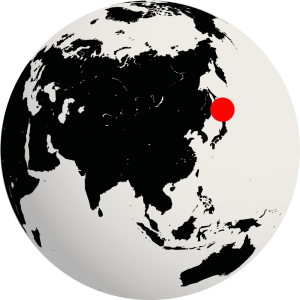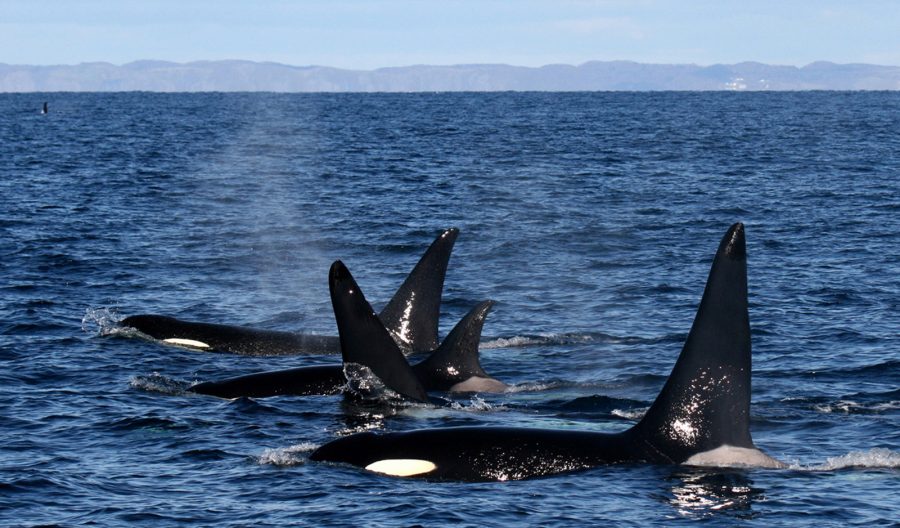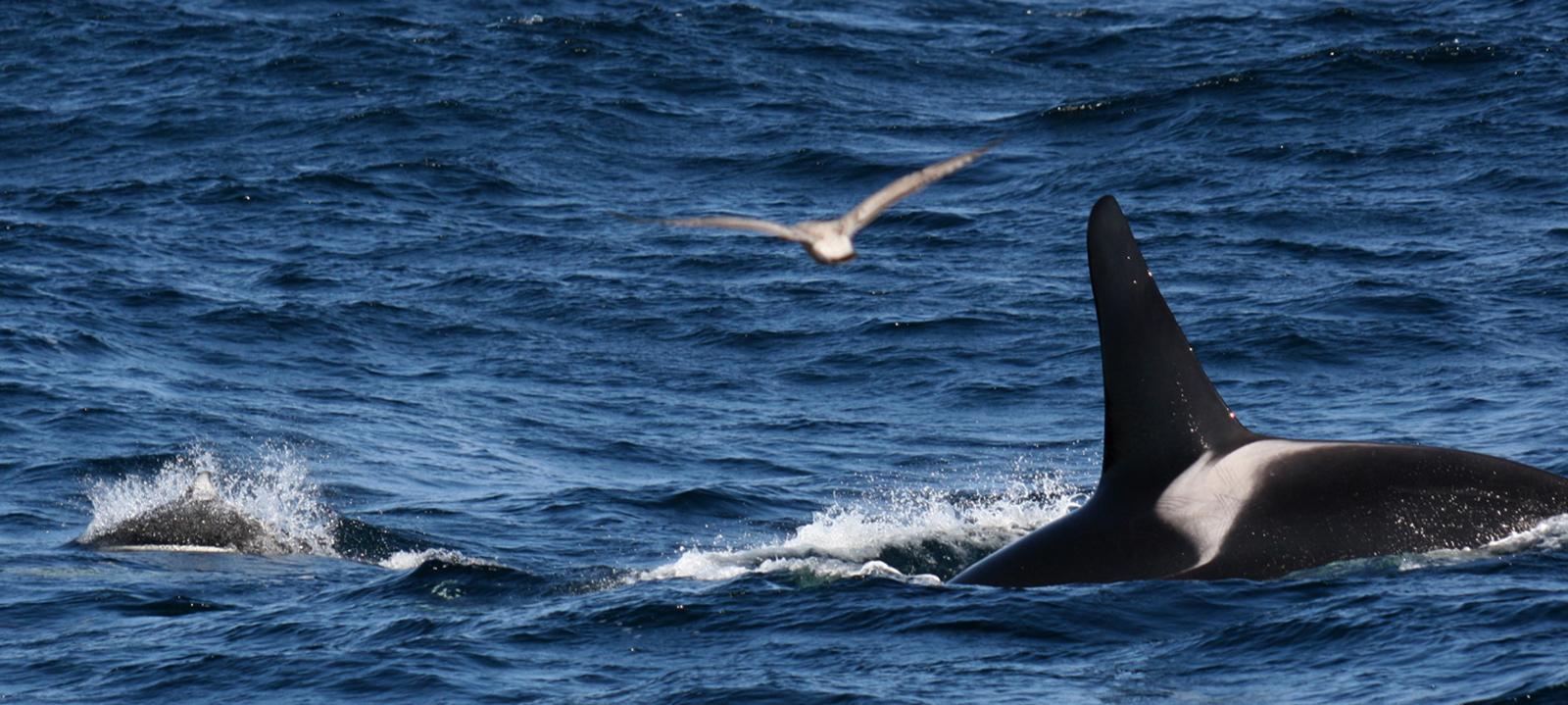In May 1997, a pod of orcas (Orcinus orca) was spotted by a whale watching operator in Volcano Bay, southern Hokkaido. This sighting soon became a sensation and was widely reported in news media. In this article I want to introduce you to the orcas in Japanese waters, focusing on groups to appear on the east coast of Hokkaido.
Written by Kotoe Sasamori / September 2018
The indigenous Ainu people of Hokkaido referred to the species in their folktales as ‘Repun Kamuy’, meaning ‘God of Offshore’. It would appear that the relationship between whales and humans was much more respectful in the past than it is today. However, by the first half of the 1970’s population numbers within the national EEZ had drastically reduced all around the Japanese archipelago and encountering one in the wild became a rare event.
 By the 2000’s the town of Rausu on the Shiretoko Peninsula had begun its transformation into a notable whale watching spot with very high encounter rates, with a focus on orcas throughout May to June. People began seeing the species in both pelagic and coastal waters more frequently than before. This success continues today. Could this be a sign of the gradual recovery of orcas in Japanese waters?
By the 2000’s the town of Rausu on the Shiretoko Peninsula had begun its transformation into a notable whale watching spot with very high encounter rates, with a focus on orcas throughout May to June. People began seeing the species in both pelagic and coastal waters more frequently than before. This success continues today. Could this be a sign of the gradual recovery of orcas in Japanese waters?
Situations of studies and observations of orcas in Japan
Due to insufficient studies, little is known about the biomass, biology, and distribution of Orcas around the Japanese archipelago. The official releases had previously been vague, stating only that orcas are relatively common in coastal waters of eastern Hokkaido at north of lat. 40 N. These limited records of observations continued throughout the moratorium of commercial whaling, a pause in commercial whaling set by the International Whaling Commission (IWC) from 1986 to around 2000.
My team has been surveying the pelagic and coastal waters off Kushiro since 2003, studying oceanological and environmental factors. We confirmed that a particular pod has been annually visiting the area for around the past decade. Other whale species have also been observed around eastern Hokkaido and Iturup, one of the Kuril islands, revealing the importance of these habitats. Additionally, two individuals seen along Shiretoko were later confirmed in Volcano Bay, southwest of Hokkaido, leading the team to believe that the pod is widely distributed among Hokkaido’s pelagic and coastal waters and not just the eastern part of the island.
The areas discussed have a rich biodiversity which is supported by the highly productive Kurile Current (Oyashio Current) and nearby upwelling and fertilization of fundamental productivity by drift ices from Russia’s Amur river in winter. Consequently, these areas are ideal habitats for marine megafaunas, and a hotspot for orcas in Japan.
Each pod among the respective areas has specific characteristics in terms of composition of members, size of pods, and behavioral patterns. In this essay, I would like to introduce the biology of these mysterious orcas in Japan, which is only just beginning to reveal itself through regularly conducted research, and observations from whale watching operators around Hokkaido.

Orcas with the city of Kushiro in the background (© Kotoe Sasamori)
![]()
Rausu (east coast of Shiretoko Peninsula) to Cape Shiretoko
Nemuro Strait is the only location in Asia where orcas are listed among the target species for ecotourism-led regular observations. Pods along the coast of Rausu have a higher calf rate than in other Asian waters. Calves are highly inquisitive around vessels, independently swimming from adults to cavort next to watchers onboard. They are also highly active, repeating surface actions such as breaching and spyhopping. However pods, are seemingly less united and individuals tend to swim freely and are scattered as a whole.
This area has a history of a mass stranding. In February 2005 a pod of 11 whales, including 3 newborn calves and a mature male, were entrapped by drift ice. A sole survivor managed to escape, albeit in a severe condition. A sighting of a floating carcass was later reported by fishermen, yet the identity of the carcass could not be confirmed as the survivor. (Read more about this event and other mass strandings)
Orcas are known to utilize their surroundings effectively for hunting, including drift ice and other geographical features. It is thought that one of the reasons behind predators, such as orcas, becoming trapped in nature’s snare is due to pods failing to read random movements of pack ices caused by warming waters. It is also believed that frightened newborns may slow down the entire pod. Therefore this incident may have been triggered by an increased number of newborns as well as a rapidly changing environment.

Lining up off Kushiro (© Kotoe Sasamori)
Pelagic and coastal Kushiro(Eastern Hokkaido)
Many of the orcas in this area usually appear around 200 meter isobaths, yet orca have been spotted in the vicinity of the Kushiro Valley, which lies about 10 kilometers (6.2 miles) off the port of Kushiro, in autumn. The valley is situated on the edge of the continental shelf, and the fan shaped marginal region of shelf waters surrounding the valley host the orca in autumn when migration reaches its peak.
“For such groups, males often act as diversions by quickly approaching vessels, and performing loud actions to gather the attention of those onboard…”
The proportion of mature males is relatively high, with cases in which more than half of the pod members are large males. For such groups, males often act as diversions by quickly approaching vessels, and performing loud actions to gather the attention of those onboard, as if to distract attention from the females and calves. In comparison to the whales along the Rausu coast, these animals are much more cautious and their movements are rather unpredictable, yet with a clearer sense of organisation within the group.
Starting with Nick the bull, 103 individuals have been identified through our research from 2005 to 2016. More than 60 % have been resighted on several occasions, indicating that around half of the total individuals or pods are only visiting, staying for relatively short periods in this area.
Southern Kuril Islands(area of territorial disputes between Japan and Russia)
During the Russia – Japan joint conference of ‘Specialists for Research of Terrestrial and Oceanic Ecosystems’ in summer 2000 to 2005, surveys, (in which I participated as a cetacean observer), covered the Yuzhno-Kurilsky District, incorporating the four southern islands of Iturup, Kunashir, Shikotan, and Habomai. Orcas were recorded on almost all expeditions in the vicinity of Iturup and Kunashir. Here, the ratio of cow-calf pairs was greater and the pods displayed a highly united structure where females took the lead, contributing to the organization of the group. Pod members swim rather tightly and create protective formations, frequently forming a barrier around the calves.

Sighting in Volcano Bay in 1997 (© Kotoe Sasamori)
Volcano Bay (Southwestern Hokkaido)
Small sized pods of around 3 members, including mature males and either females or subadults, have been observed annually around southwestern Hokkaido. Additionally, larger pods consisting of around a dozen animals appear during summer with intervals of 3 to 5 years. Such groups form a unified structure despite containing individuals of various ages and sex groups, including males, cow-calf pairs, and subadults. Many groups often display highly cautious and unpredictable behavioral patterns.
Despite orcas appearing in and around Volcano Bay almost annually during the winter months, their migration patterns remain elusive (short stays with neither individual or pod resightings) and the limited amount of data leaves the biology of these whales yet to be unveiled. Fourteen individuals in total have been identified as of 2003.
Identification
We can identify individuals by creating ID catalogues based on distinct markings and features on the whale’s dorsal fins and saddle patches. This is essential not only to understand elements such as frequency of visits by specific individuals, compositions of pods, and inter-pod relations but also to verify any connections between pods from differing regions. Catalogued individuals, sorted according to their respective areas are known rematches: A (pelagic Kushiro), B (Shiretoko coast), C (southern Kuril Islands). We find that one male has been confirmed among them all, two males in A and B, one male and one either a female or a subadult in B and Volcano Bay, one male and one either female or subadult among B and C, where this particular male has been resighted among entire regions of eastern Hokkaido. Considering the distances and continuities of the above waters, even more matches are likely if more information can be shared by institutes and watching operators in different areas/basins.
The necessity of continuing individual identifications and inter-area cooperation is great, in order to reveal whether the small amount of rematches above are due to a paucity of information or due to the actual rarity of such migrations.
Determing the Ecotype
Three ecotypes of orcas, transient(so called Bigg’s Orca), resident, and offshore(Ford et al.,1999, 2000), have been classified along the Northeastern Pacific coast (NEP). These classifications are based on the studies of characteristics including diet, vocalization, and lifestyle. I would like to consider these characteristics in the case of Hokkaido’s orcas.
Orcas of Volcano Bay have been observed pursuing minke whale(s), and their stays within the nearby area have mainly been for short periods of no more than 2 days, with no re-sightings. These characteristics are demonstrative of mammal-eating transients, or at least something similar to that characterization.

Intensely pursuing Dall’s Porpoise off Kuashiro (© Kotoe Sasamori)
Animals here have been confirmed to either track cetaceans or prey on seals resting on drift ices during winter. In light of the previous evidence and judging from their temporary appearances in specific areas annually, these whales are possibly mammal-eating transients. Notably, the pattern of diminished or absent vocalizations when in pursuit of cetaceans is akin to the transients from NEP. Furthermore, the genotype, which was obtained from the mass stranding of Rausu in February 2005, corresponded with that of the Bigg’s Orcas.
On the other hand, about half of the individuals and pods have been regularly resighted; the migration cycles of Kushiro’s orcas stay within the same areas for temporary periods and therefore would be better characterized as seasonal residents rather than transients.
Furthermore, pods of 15 to 20 individuals preying on and attacking various species of cetaceans, such as Dall’s porpoises and balaenopteridae (Minke and Fin), off the Kushiro and Rausu coast have been observed. Putting this into a global context, this behavior is more akin to ‘Type A’ orcas from Antarctica, which form larger pods to hunt baleen whales, as opposed to ecotypes from NEP. In NEP, Bigg’s groups are smaller in size, generally containing no more than 10 members, while fish feeders (residents) tend to form larger pods.
Coexistences of mammal-feeding transients and residents with fish diets have been confirmed, and the mysterious “Offshore” types also occasionally appear along Kamchatka, where some of the Rausu individuals are expected to migrate. There is still a lot to learn along the eastern Hokkaido coast, including possibilities of the coexistence of different ecotypes within single areas, and the existence of omnivorous feeders, feeding on both fish and mammals, as is the case in Russia’s Far East.
“The study of the orcas of Hokkaido is relatively new.”
The study of the orcas of Hokkaido is relatively new. Therefore it poses the question as to whether the biology of these orcas should be considered according to the categorization of NEP’s ecotypes, especially in regards to pod size and behavioral patterns. It is predicted that more light will be shed on these matters as the results of ongoing and future studies are collected.
In 2016, my team launched a new project using drones to collect DNA samples from the blows of the orcas. In addition to this DNA study, we can use the visual identifications and acoustic data collected around Hokkaido since 1997, to create a more comprehensive picture.

A whale investigates a research vessel off Rausu (© Kotoe Sasamori)
Future of orcas of Japan
Known distributions of orcas are gradually increasing around the Japanese archipelago at present. Kushiro has been monitored by NGOs, including my team. Furthermore, locations around Hokkaido, where occasional encounters such as in Volcano Bay, Abashiri, coastal Rishiri Island, along with the west coast of Hokkaido have recently been acknowledged. Confirmation of the presence of orca among various areas around the whole of Japan are increasing at a quicker rate than expected; from Honshu to the Ryukyu Islands, around the Korean Peninsula and off the east coast of Taiwan.
This may be true not only of orcas but also of other marine vertebrates. It is not yet clear what is behind the increase in recent sightings: actual recovery in population size, higher encounter rates due to ease of accessibility to offshore areas by the public, developments of internet and recording devices, or all of the above.
It would be my honor as a cetologist with over 20 years’ experience studying the orcas of Japan if this essay could shed light on your understanding of the orcas that the world doesn’t know about.
![]()
About the author
 Kotoe Sasamori (Facebook)
Kotoe Sasamori (Facebook)
Marine biologist and researcher, and nature photographer since 1996.
Born in April, 1963. Born and lives in Muroran, Hokkaido.
President of Orca.org, “Team SAKAMATA” which is a team of marine specialists and was launched in 2007 to focus on marine researches and environmental education programs, and so on. Joined on number of cetacean researches including Russia – Japan joint surveys of ecosystems in Yuzhno-Kurilsky District from 2000 to 2005, six nations joint research of Baiji/ Yangtze River Dolphins in 2006, studies of marine ecosystem of Shiretoko, orca surveys off Kushiro. As a photographer, providing images and footages to research organizations, educational institutes, and the press internationally and domestically.
Translator
Yasutaka Imai
Citizen scientist and businessman.
Born in August, 1988. Born in Ueda, Nagano and lives in Nikko, Tochigi. Studies cover wide ranges of natural histories of marine mammal s while being focused more on shedding lights on notable obscure records by publics.*1 Being involved in international projects of cetacean researches such as Western North Pacific Right Whale ID Catalog Project*2, Sightings of western gray whales around Japan, cetacean diversities in Gulf of Tonkin waters, Bryde’s/ Eden’s whale researches in Gulf of Tonkin, and so on.
*1 E.g. (http://www.cbs8.com/story/35905952/biologists-say-whale-seen-off-la-jolla-was-extremely-rare) (https://www.taiwannews.com.tw/en/news/3169584)
*2 (http://onlinelibrary.wiley.com/doi/10.1111/mms.12243/abstract)
English Editor
Leanne Dixon
Cetologist and English teacher
Born in December 1989. Born and raised in Wigan, England. Have a BA (hons) in English Literature from Cardiff University. Moved to Osaka, Japan in 2016. Studied wild bottlenose dolphins in the U.K as a research intern with Sea Watch Foundation. Currently, teaching English in Osaka and assisting with a dolphin research project at Kindai University.

 Nederlands
Nederlands